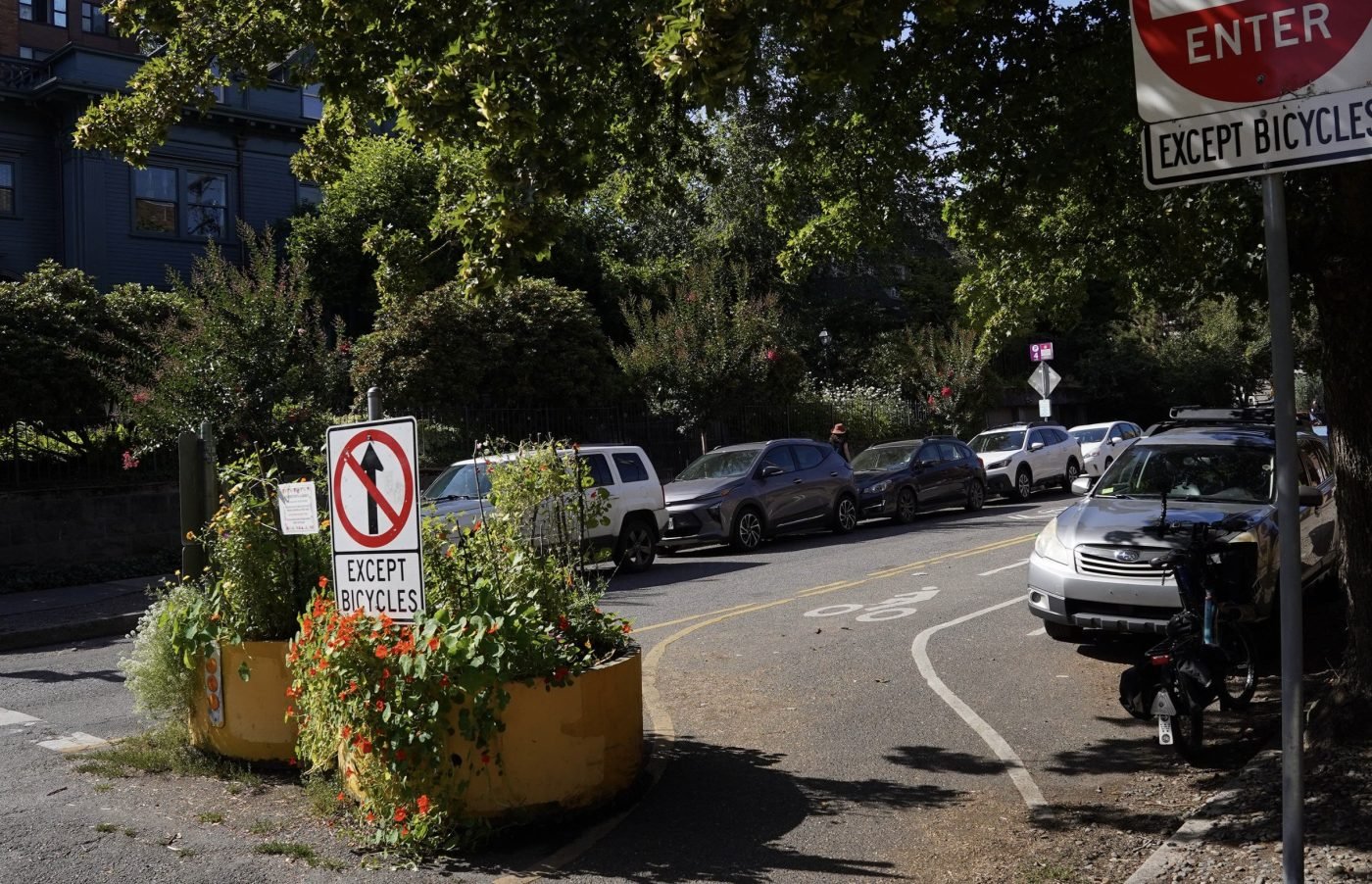
A plan to remove traffic diverters on two neighborhood greenways in northwest Portland that has been developed largely behind closed doors, appears to be moving forward. Or does it? So far there’s a lack of clarity about why they’re targeted for removal and when it might happen.
The locations in question are NW 20th and Everett and NW Johnson at 14th and 15th. In all three locations, the Portland Bureau of Transportation has installed concrete barricades that prevent car users from turning onto a street, while allowing bicycle riders through (that’s why they are also known as “modal filters,” because they filter out car traffic).
As I reported Friday, the leader of Portland Solutions, a city program created in 2024 and overseen by the Mayor’s office to address homelessness and livability issues that, emailed District 4 City Councilors and other city leaders to inform them that these diverters would be removed. “We are working diligently with [PBOT] Director [Millicent] Williams to ensure these changes occur quickly for the benefits of all community members in NW,” the email from Portland Solutions Program Director Skyler Brocker-Knapp read. The only rationale for this decision provided in the email was to make it easier for Portland Police Bureau (PPB) officers to navigate the streets because the locations of these diverters, “have been particularly problematic in terms of chronic nuisance behavior (drug dealing, vandalism, etc.).” “These were public safety requests and we appreciate partnering with PBOT on these efforts,” Brocker-Knapp wrote.
These diverters are part of a citywide strategy to reduce driving, encourage bicycling, and calm traffic. They are part of a network of neighborhood greenway streets that allow bicycle users to navigate the city in a lower-stress environment and the locations in question were vetted and recommended through a formal process known as the Northwest in Motion plan, which was adopted by City Council in 2020.
That’s why I’m curious to understand more about how the PPB and Portland Solutions are able to mandate their removal with little to no public input. So far, I haven’t heard satisfactory answers to my questions and I remain very concerned not just about the impacts of removing these diverters, but about the precedent we would set by doing so.
The official rationale given by Director Brocker-Knapp was that the PPB needs to more easily navigate these streets so they could address crime hotspots (the diverters create one-way streets for drivers). But since my story published on Friday, I’ve heard other reasons behind the desire to remove them.
A Portland Solutions spokesperson shared with me in a phone call that the removal was, “An ask that came from PPB and PEMO [Public Environment Management Office, another program under the Portland Solutions banner] based over several months of conversations with the community.” I emphasized “community” because that’s an additional rationale not offered in Brocker-Knapp’s email and it speaks to reasons for the removal that go beyond making PPB patrols easier. Those “conversations” referenced by the Portland Solutions spokesperson likely happened at twice-monthly meetings of PEMO’s Problem Solver Network, which the city describes as, “an initiative to address community public realm issues across the city.”
The same spokesperson went on to tell me that their office heard about bicycle riders who are were afraid of using NW Johnson between 15th (where the diverter is) and 16th because of general safety concerns. According to them, the combination of a dark underpass and lack of auto users (due to the diverter), equates to a lack of “eyes on the street” and increases cyclists’ sense of danger. From what I’ve learned working on this story, some of the people behind this diverter removal plan believe having more drivers on these streets will increase visibility and make the streets safer. That line of thinking is not supported in any city planning document and goes against the City’s adopted principles of Vision Zero.
To better understand the issues surrounding these diverters, I visited NW Johnson and NW 20th over the weekend.



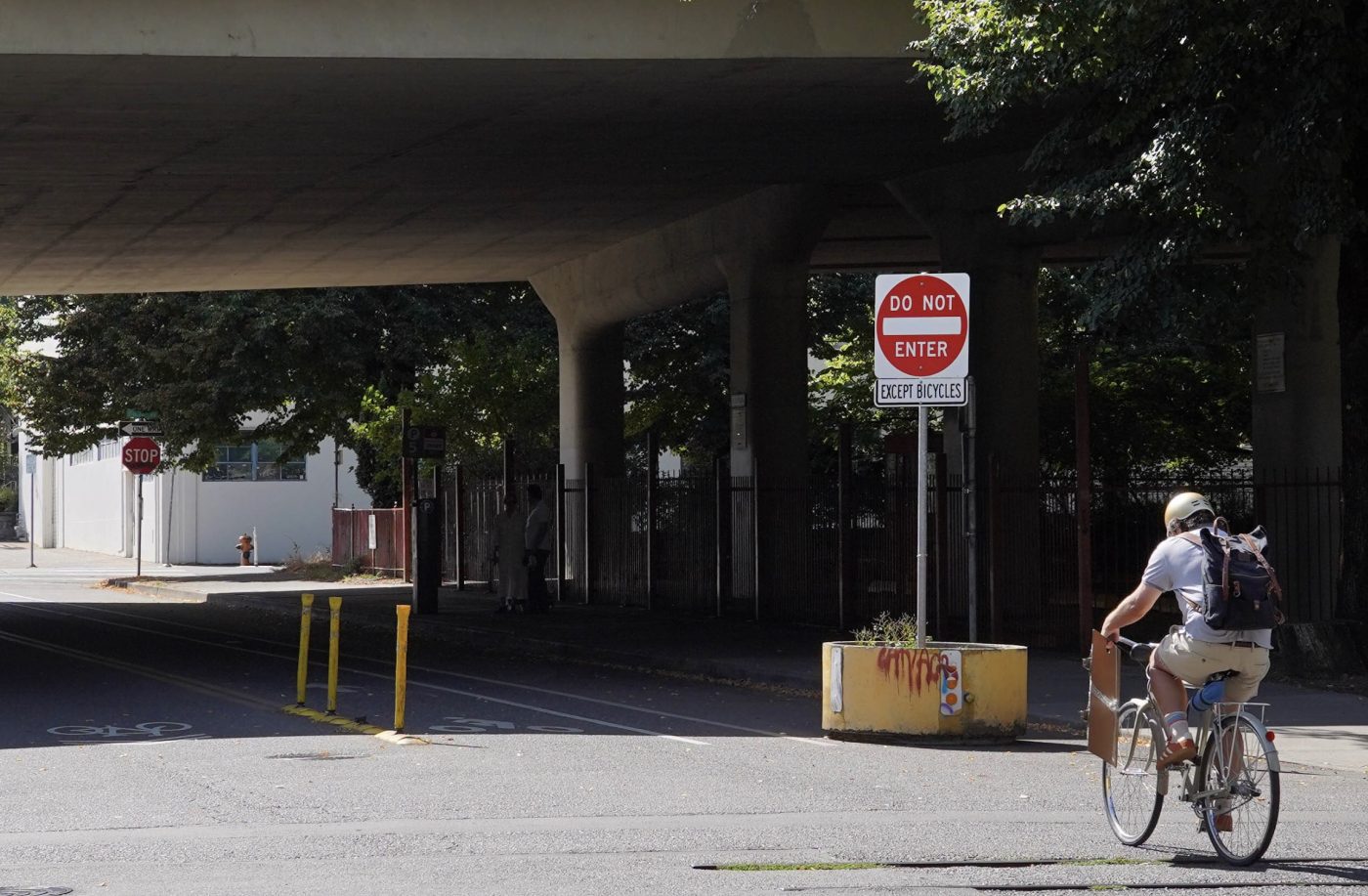
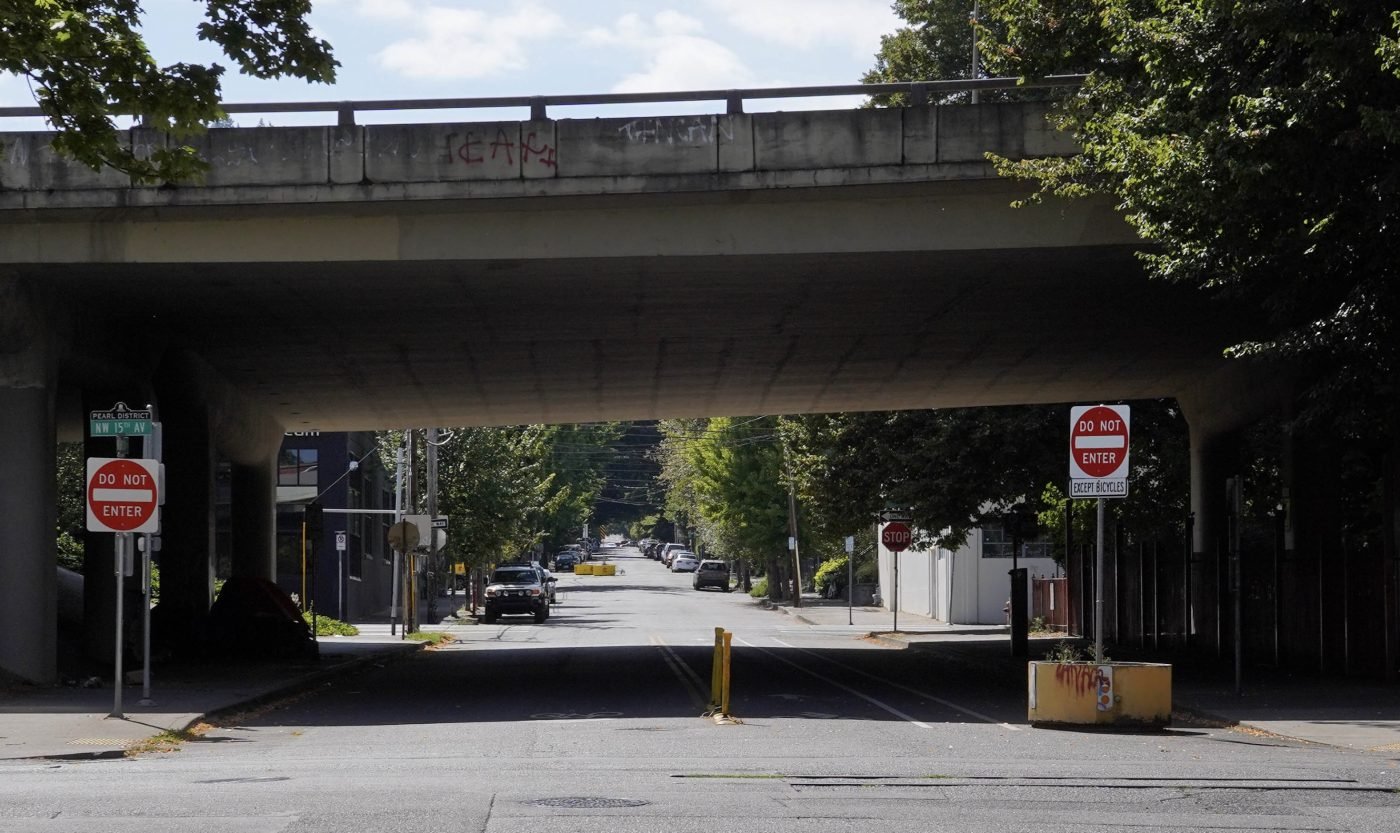

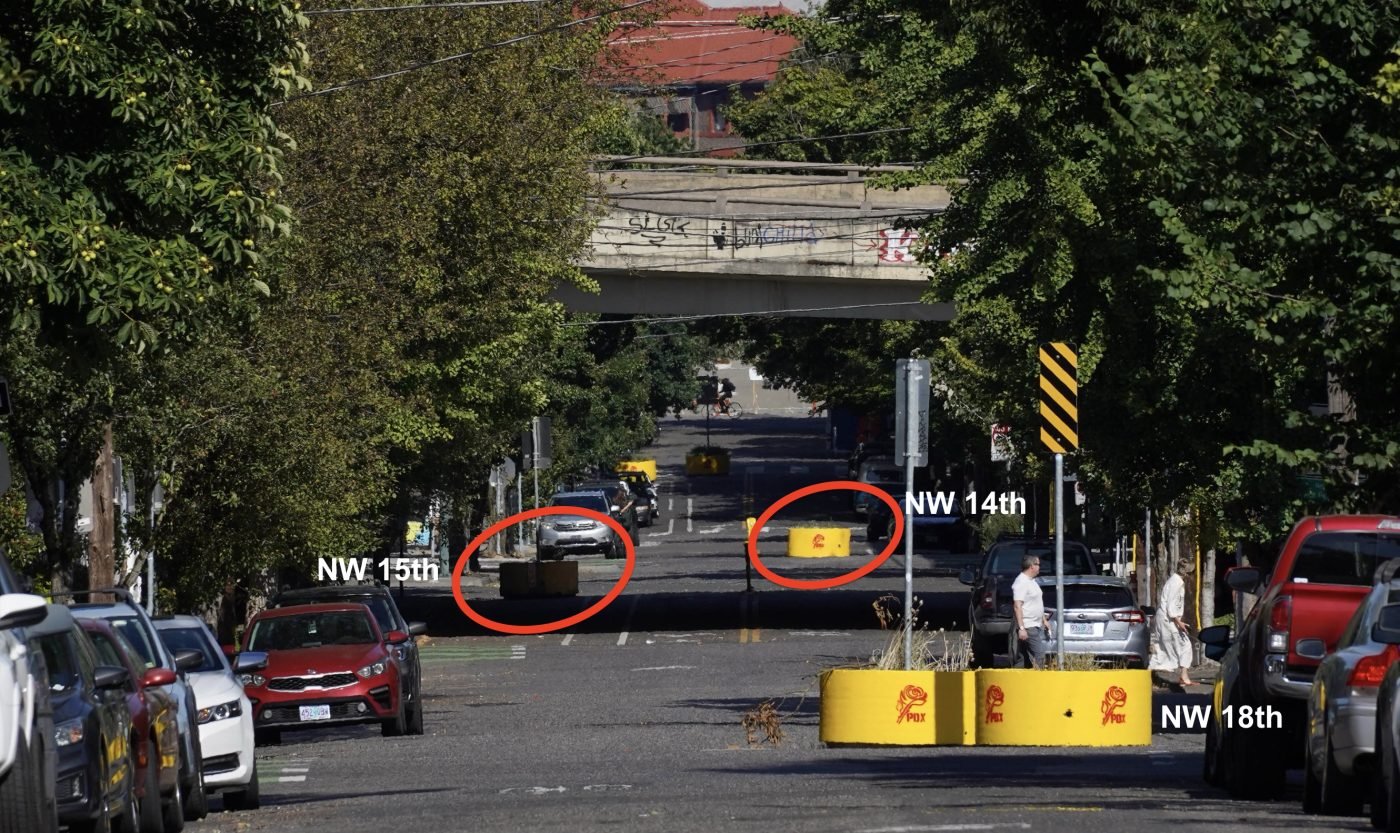
NW Johnson between 14th (the old REI) and 15th was very quiet. There were more bicycle riders than car drivers using the street in the 15 minutes I was there. And all the bicycle riders used the bike lane adjacent to the diverters. There’s just one diverter at 15th, which means there’s ample space on the street for a police officer to drive through in either direction. I also noted how these diverters are part of a strategic, alternating series of one-ways designed specifically to reduce car trips. Prosper Portland’s Broadway Corridor Plan says the neighborhood greenway is a key part of the development’s goal to minimize car traffic on NW Johnson when it is extended through the site to connect to Union Station. “Neighborhood greenways should be developed on NW Johnson Street,” the plan reads, “with volume and speed management features that limit the amount of auto traffic using the street.”
If these diverters on Johnson are removed, it would defeat the purpose of the neighborhood greenway — which is by definition supposed to remain under a specific threshold of cars per day (1,000 cars per day is the target).

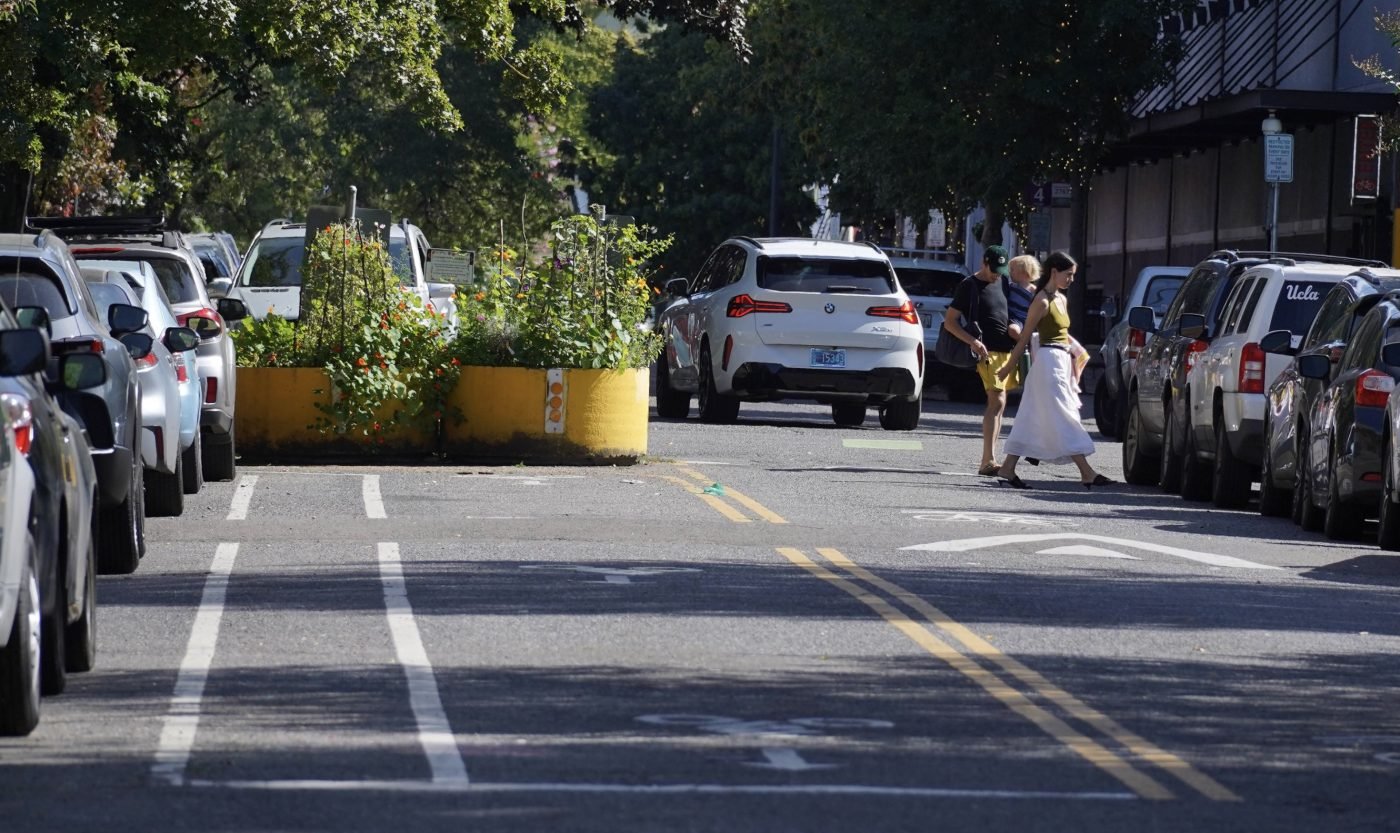
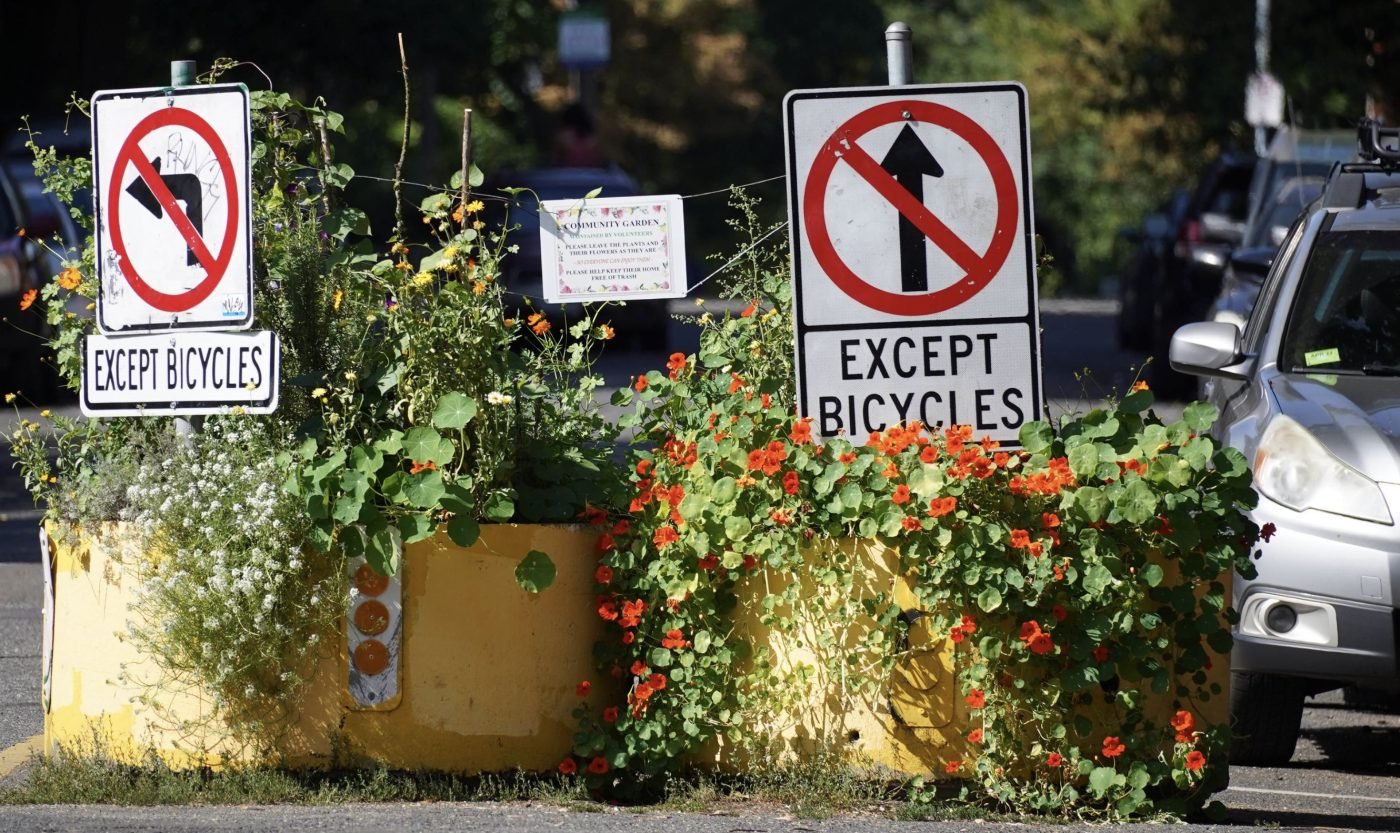

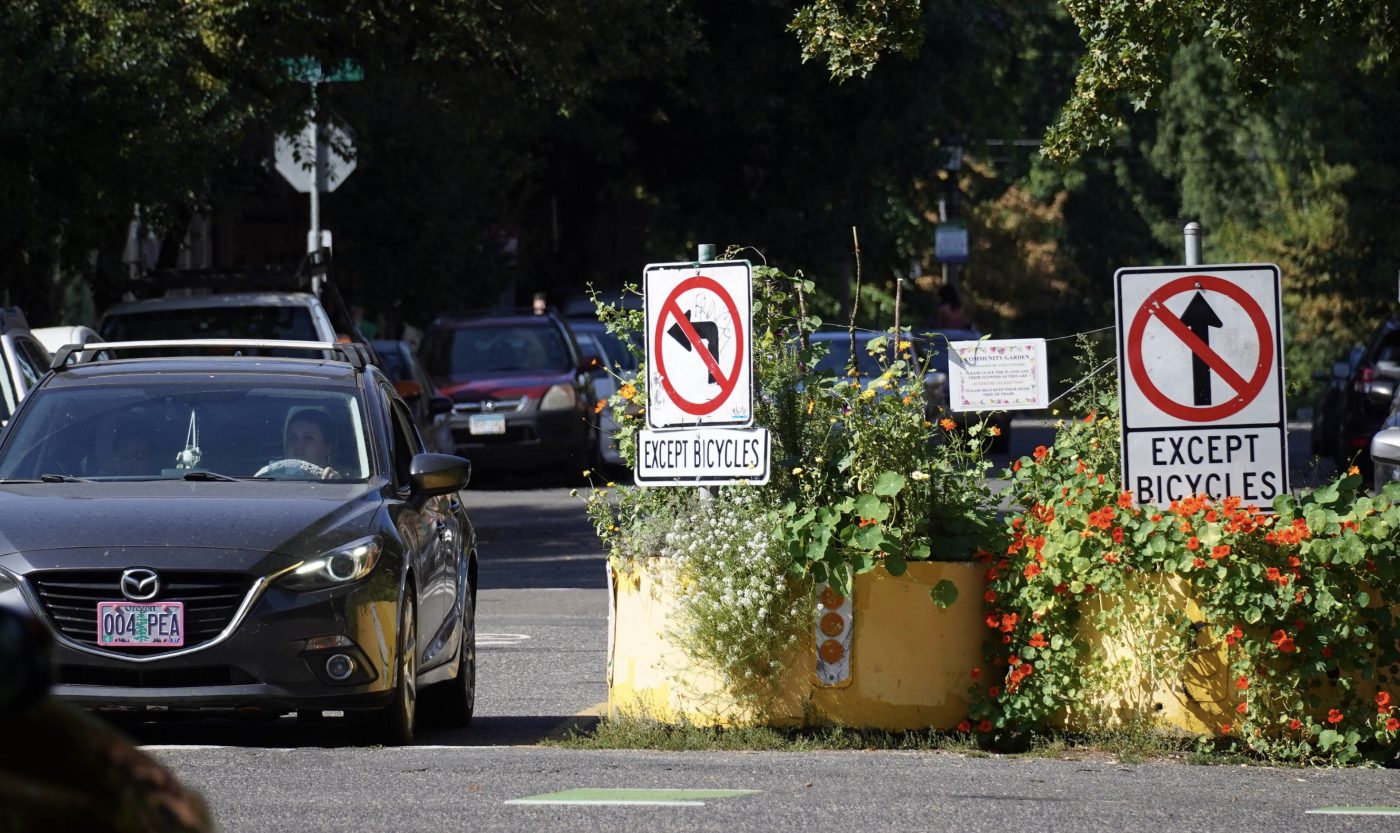
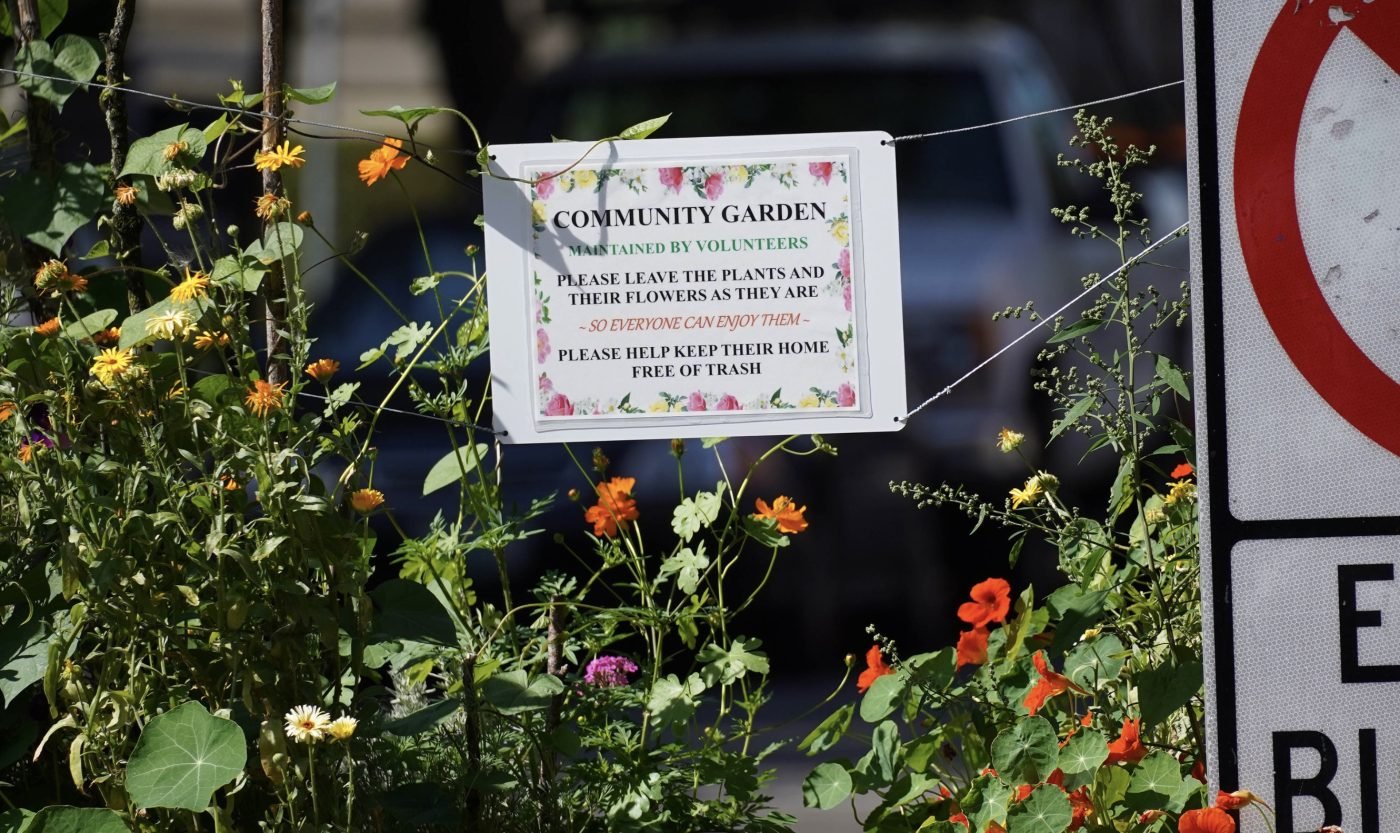
Over on NW 20th at Everett (just one block from where U.S. Congresswoman Suzanne Bonamici was hit by a car driver while walking in a crosswalk in 2023), I found a bustling streetscape adjacent to multi-story apartment buildings and Fred Meyer store. That part of the Nob Hill neighborhood is dense and the intersection of 20th and Everett had a constant flow of drivers, walkers, bicycle riders, scooter users, folks in mobility devices, and so on. The two concrete barriers the create the diverter in the northeast corner of the intersection help calm the intersection by eliminating one option for drivers. Since 2022, this greenway on 20th has been an important north-south street in the bike network that connects to other greenways on Flanders, Johnson, and so on.
I also noticed that if the city removes this diverter, they’ll also be removing the community garden that has sprung up inside them. The two large concrete barrels are filled with soil, plants, and flowers that spill over the sides and onto the street. “Please leave the plants and their flowers as they are so everyone can enjoy them,” reads a sign hanging by a string between to “Except Bicycles” signs.
There would be a significant impact to road conditions in northwest if these diverters are removed. For that reason alone, I’m surprised at how this plan to remove them has emerged largely outside public view. The Problem Solver Network meetings where issues were apparently first raised are not easy to access by the public. Their website doesn’t list dates or times and there are no meeting minutes or agendas to review.
If, as Portland Solutions maintains, these diverter removals have been discussed for several months/years, that means there’s been plenty of time to notify the public and seek feedback to make sure it’s a sound decision. When the removal was announced last week, there hadn’t been any outreach to the City’s Bicycle Advisory Committee, a body that exists to help advise on this exact type of issue.
I’ve got questions out to Portland Solutions and others to learn more about the rationale behind this decision and to find out whether or not the removal is imminent. And I’m not the only one.
“Keeping the diverters intact is the outcome Councilor [Mitch] Green is working toward and at a minimum wants to get a comprehensive understanding from officials responsible why removing these diverters is justified,” Green’s Chief of Staff Maria Sipin shared with me today. “Our office is concerned that this could initiate more removals if the public and City Council aren’t informed.”
I’m still waiting for more clarity. But at this moment I’ve heard mixed signals about how imminent the removals are. I’ve heard the order to remove them is final and that City Administrator Michael Jordan is moving forward with it right away. And the email from Brocker-Knapp used the word “quickly”. But Portland Solutions shared with me Friday that, “We’re in the early stages of this,” and that, “I still think that there’s time for engagement.”
A local urbanism advocacy group that supports the diverters is meeting tonight to talk about the issue and leaders from Portland Solutions are expected to attend the PBOT Bicycle Advisory Committee on August 12th. Let’s hope they remain on the street until at least that meeting so we can better understand the argument against them.
This issue is not just important from a traffic safety and planning perspective, it’s a test of how public engagement works (or doesn’t) in Portland’s new form of government. So far there’s been a major lack of transparency around how the decision was made. In the past, anyone concerned about this could contact the commissioner in charge of PBOT. But now we have city administrators who oversee PBOT and they’re not set up for easy public contact. The page on the City’s website that lists City Administrator Michael Jordan and Deputy City Administrator of Public Works Priya Dhanapal, for instance, doesn’t even have individual contact information.
If you care about this issue and want to make your feelings known, use this form to contact city leaders (in addition to leaving a comment here so city leaders can read it).
I expect to hear more from Portland Solutions and others in the coming days and will continue to monitor this issue closely. Stay tuned.
— For more details, don’t miss my initial story posted on Friday.



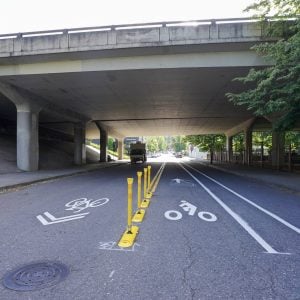
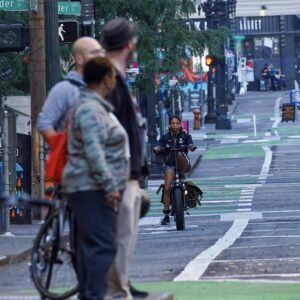

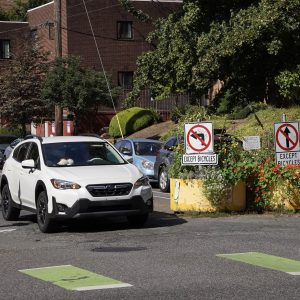
Thanks for reading.
BikePortland has served this community with independent community journalism since 2005. We rely on subscriptions from readers like you to survive. Your financial support is vital in keeping this valuable resource alive and well.
Please subscribe today to strengthen and expand our work.
This is exactly the sort of opaque, short-term decision making that is infuriating from city officials. As you lay out in the article there is no way removing these diverters is in any way in line with the broader stated goals of the city in terms of safety or transit, and seems to be purely in response to some combination of police and local busybody requests. At least Commissioner Green is fighting the good fight, as this would be a terrible precedent to set.
The transparency and accountability of our new government run by unelected bureaucrats is a thing to behold.
Soren,
This is what the voters wanted…the new charter put control in the hands of professional managers, right?
I’d love to know who exactly “from the community” suggested removing these. Because I live nearby and they’re quite well enjoyed, especially the one on Everett.
Me too. I’m hoping to learn more of that type of information soon.
“Community” = Portland Police
It’s stuff like this that burns out advocates.
In the best case scenario, you spend years going to public meetings about a plan, and maybe some of the plan gets implemented.
In this case, they’re removing the crumbs that advocates were given, and without any public process.
Great demonstration that “quick build” = “quick destroy”
This seems to be a great example of the discrepancy between the process that advocates and typical citizens navigate with their hard work, and the process that actually influences political decisions.
When things like this happen in NYC, Transalt often (not always) has the connections, money, media exposure and rapid organization to make decisions like this transparent. Most often there is a single player with money (e.g., Mcguiness Blvd). Portland just doesn’t have that level of organized, funded advocacy to lay bare this type of idiocy and power-play.
The burden of evidence for the city’s redesign decision isn’t something the mayor’s office feels like it needs to supply because safe street advocates hold little power. The mayor’s office can simply use euphemistic and bureaucratic language to sidestep any effort for a substantive and transparent decision (you may have gotten the same email):
Great point about the influence of TransAlt and how a well-funded and organized advocacy group can fight this type of stuff. I agree that Portland is missing that type of group.
I mean it’s also often relevant to prevent this type of undue interest by framing issues prior to some rich dude stepping in and making their money talk. If the city had solid data on how many people support a project, media had a consistent spokesperson to go to, and donors had a single place with teeth, the city (or rich dude) might check with that org first before pulling this shit.
NYC mayor Adams has consistently burned all his bridges with friends in the street advocacy network, but he also isn’t able to resist them 90% of the time. Bedford is one of his few “successes.” 34th (in process), 10th Ave, McGuiness, etc. all got built despite strong opposition by dude with coin.
Just because Portland is small potatoes compared to NY, doesn’t mean we can’t have a successful, organized, well-funded advocacy group. Mayor Wilson isn’t half as hostile to safe streets, but he’s not going to stick his neck out. Hopefully, BikeLoud will fill those very, very empty shoes. But it needs to emulate Transalt and involve people with specific grassroots campaigns (e.g., Canal) to be taken seriously, and not get bogged down in abstruse, unachievable goals like a lot of orgs typically do.
I received the same infuriating email. The worst part is that one little clause at the end: “while allowing for bike travel.”
Translation: “You can still ride your bike on the street! What are you complaining about??”
For the sake of public record and visibility, here is the message I’ve written to the city administrator, PEMO, and one other elected official (TL;DR – I am 100% against removing bicycle infrastructure in this city):
I am a resident of SE Portland and a former resident of NW Portland.
It has come to my attention that you’ve been directed to remove bicycle infrastructure on NW Everett and 20th, NW Johnson and 15th, and NW Johnson and 14th. I am writing to ask you to reconsider this position.
As a middle class resident of Portland, I have greatly benefited from Portland’s (somewhat weak) commitments to making it easier to move around the city on foot, bike, and transit. This vital infrastructure helps keep me safe and its presence gives me a small bit of confidence that the city of Portland is serious about discouraging driving in favor of healthier and more sustainable modes of urban transportation.
Furthermore, the ability to get around without a car in Portland has increased my quality of life and allowed me to save thousands of dollars over the years. A move to reduce infrastructure that allows for a car-less lifestyle makes living here more stressful and expensive. Surely, you don’t want to push residents away, do you?
It is deeply concerning that a decision to remove infrastructure can happen so quickly without any public input. We should absolutely make driving more difficult, especially in one of the city’s densest neighborhoods. We should be heavily investing in ways to help residents of NW Portland get around by bike and we should be actively lobbying for future rapid transit routes through the neighborhood (subway ala underground MAX).
We need to be thinking like urbanists – how can we make the city more livable, lively, and pedestrian friendly? Allowing quick shortcuts for cars does not do any of that. In fact, it reduces livability and makes streets more dangerous.
And if it’s a matter of public safety officers accessing neighborhoods, we can either A) design infrastructure that allows them to use it in emergency situations or B) evolve PPB to use vehicles that fit the landscape. I have seen many shapes and sizes of emergency vehicles throughout the world and there is no reason why we can’t right-size our own departments to fit the landscape we are trying to build (more bike patrols, smaller patrol cars, more foot patrols…).
I used to live in District 4 and I welcomed all the new bike infrastructure. It was immensely helpful in getting around and I noticed a visible uptick in bicycle traffic. I highly encourage you to double down on investing in bike infrastructure in NW Portland. I know there are loud residents that complain about the inconvenience of being able to drive on certain routes and use undemocratic means to get what they want, but we should not let some angry grumblings dictate public policy. A city with a healthy and vibrant pedestrian and bike culture is more physically and mentally fit.
For the sake of public health, please do not remove this important bicycle infrastructure.
You seem to believe that each decision of an elected government must first have approval of biased activists like yourself. Topping it a bit grand aren’t you?
As opposed to unbiased activists?
Wow you seem to have an opinion Bob, you fancy yourself a senator do you?
⬆️ Biased activist
That’s what activism is: advocating for your “bias” AKA “opinions.”
I fully support keeping these diverters intact. It’s hard to quantify the effect of one single modal filter, but I can say that these specific diverters make it much more comfortable for me to visit and support businesses in the Nob Hill & NW 23rd areas. Their removal and subsequent uptick in car traffic on greenway streets would encourage me to spend elsewhere.
This is why Jordan was installed, and much of the new city structure made, by Wheeler before he left. Can’t have the rabble and 12 troublemakers running the city just any way they choose! Gotta make sure someone can reverse some of the craziness… but behind the scenes, like Ted liked to do.
We went from a weak mayor to a weak mayor+strong un-elected administrator(s) (e.g. wealthy executives with close ties to business leaders and the PMC).
PS: City council should have hire/fire power over adminstrators (and we should just get rid of the mayor)
“Can’t have the rabble and 12 troublemakers running the city just any way they choose! ”
The shape of our new government was a decision made by the framers of the charter, then affirmed by Portland voters, not by Ted Wheeler or Michael Jordan. And council can still pass a resolution requiring diverters wherever they want, or otherwise forcing the issue.
Wheeler did considerable work structuring the new governance and employee roster before he left. Installing Jordan as City Manager, and others aligned with him in management positions, rather than letting new councilors choose them, for example.
Voters approved a new car and a new driver for it – Wheeler picked the driver, not the new council, in essence.
LOL
My memory of the area under the bridge at Johnson is that it was very unsafe and cars did nothing to prevent it.
Yes — the conditions in that area predate the diverters, and their presence or absence won’t make any difference.
I think the common word for what Layne is claiming is called a “lie”.
Keep digging, Brockner-Knapp is a failover from the failure that is Ted Wheeler, this is 100% NIMBYism
Pre-Covid a company decided it was going to move to Old Town from a better part of downtown to save on lease costs. Needless to say the employees were not happy. The executives justified it as their company, with all their employees, would help make Old Town safer because there would be more “eyes on the streets.”
Eventually 2 employees were assaulted while out for walks and another was attacked when they were headed to their car to go home for the night.
It did not make the streets of Old Town safer at all, so why do they think this neighborhood would?
Portland Solutions staff is… bored? Invite them for a bike ride.
At least some of the Portland Solutions folks routinely commute and attend meetings by bike.
The fact that this decision has made it this far is infuriating. Once again, it feels like we are having to deal with the corrupt backroom dealings that have dragged Portland backwards to suit the whims of some jerk(s) with insider influence.
Johnson is a major bike route to Providence Park from N / NE Portland. When my family and I are riding on this route. Sometimes later at night, my primary concern is drunk and speeding drivers. And, yes, there are a lot of them in this area, especially on weekend nights. Ignoring major stakeholders or major interests like having more events at Providence Park with less people driving to those events is a complete and total failure of fair governance.
While one hand is putting in time and money into campaigns to get people not to drive, the other hand comes along destroys the progress being made.
On the one hand, Portland is begging developers to build residential in the central city, and begging people to come enjoy downtown, and retailers to stay with another freaking tear-jerker story in the Oregonian every week, but when people actually go to the central city, it’s “here’s your car sewer, good luck crossing the street, watch your back, better not let your kids bike in this neighborhood.”
My family and I ride home from the Thorns games at Providence park by taking 20th across to Flanders and then taking the Flanders bridge east. The ride feels crowded and sketchy until we hit the modal filter at Everett and then we can breathe a sigh of relief and relax as the crazy car traffic dies away. Please reconsider removing this auto diverter!
(Also sending this to the address linked in the article)
Thank you for your reporting and bringing this to everyone’s attention. Seems in bad faith to all the out reach gone into getting these implemented. And what are the local residents that get quieter streets nearby think? Where is that outreach? I get PPB has a concern, but it needs to be weighed against all other stakeholders this project was for.
I haven’t used the Everett filter but really enjoy the Johnson underpass. I don’t think adding cars would add to feeling safer nor change the houseless situation in any way.
I’m sorry, but this is simply not true. In the years I lived in Portland (1997-2015) there were numerous instances where the city and PBOT made very sudden decisions without any public input, with lots of affected individuals, NAs and nonprofits complaining, particularly east of 82nd. Various groups would complain to the PBOT commissioner and get nowhere fast. Typically it became far more effective to complain to Metro and state legislators to get the city to do a 180 on a dumb decision than it was to get the council to make the right decision.
In most cases, the dumb decision had nothing to do with the commissioner or PBOT director, but rather some senior PBOT engineer who got a directive from the mayor’s office to make a change, who in turn were “advised” by the fire chief or senior staff at the police bureau. The blunt reality back then, and likely still today, is that no one knows exactly how the city actually operates, and those “in power” would prefer to keep it that way.
What I find interesting is that the poor city governance that East Portland has had by Portland since annexation in the late 1980s has now spread to the rest of the city.
Your dedication to following Portland issues after being away for ten years is really something.
We’re now all supposed to have not one, not two, but THREE elected reps who are supposed to carry the water for us on issues like this one. We’ll see what they do – probably nothing. My money is on nothing.
Call 3-1-1 (503-823-4000) to secure phone numbers, email, etc.:
Michael.Jordan@portlandoregon.gov
Priya.Dhanapal@portlandoregon.gov
Office of the City Administrator
503-823-7769
Thanks for sharing! I emailed the city administrator and all three District 4 counselors.
Michael.Jordan@portlandoregon.gov
councilor.green@portlandoregon.gov
Councilor.Zimmerman@portlandoregon.gov
councilor.clark@portlandoregon.gov
Does anyone honestly believe that a call comes in to the PPB about a homeless person causing a disturbance, and officers immediately drop what they are doing and rush as fast as they can to the scene?
“According to Layne, the combination of a dark underpass and lack of auto users (due to the diverter), equates to a lack of “eyes on the street” and increases cyclists’ sense of danger”.
Well shoot, by this metric, that’d make Powell Blvd one of the least dangerous feeling places in the city for people to bike.
PEMO/Portland Solutions has a pre-conceived answer that they’re scrambling to justify.
We need to expand our concept of public safety. I don’t want police cars zipping around neighborhood streets, even if it’s in pursuit of a “criminal.” Law enforcement should be subjected to traffic calming as much as anyone in dense neighborhoods.
Police could expand bike patrols.
https://news.google.com/read/CBMiwgFBVV95cUxPbVNjN2h6OVJjMEdna0NadE9wZ2lvUGUzU1VDeG5xd3dnQ3FyUEdiSTY4ZDZEdi16NmQ2MlVqUmcwUjFfd2FiWEhETWo2U3U4ZFFLNVpRMTFCYnJEVTRmM0V3MDdpc2dpOVVYbm5hWThJZElyMGxRV3NQa0hualhfczVsYmoxVmwyd3h2Zm1FUXBTQ0RVdGpJa3RBR0M5bWw0M0UtWExFcXV2d21vQl9XRmw5b05IZXJXSVlNQjYwNE1mQQ?hl=en-US&gl=US&ceid=US%3Aen
These 6 people are supposedly setting the agenda for the city.
Call or Email them.
They appear to be totally ineffective doing anything but you all voted them in….
wait so they’re “setting the agenda for the city”… yet they are also “totally ineffective doing anything”? I don’t understand.
The article stated that they are setting the agenda for if you bothered to read it.
You would think that HALF the city council could stop this nonsense if they wanted to.
I read the article this morning. It shows a bloc of politicians strategizing together on how to pass their stuff. To me that’s what they are supposed to do and it shows they are effective.
Also, this particular situation with the diverters isn’t easy for them to stop even if they wanted to. And therein lies the rub. It has happened very quickly and without any public notice. I heard one city councilor didn’t even know about it until Tuesday. And in the new form of gov’t, it seems like the councilors can be kept out of the loop on something like this since the Portland Solutions office reports directly to the Mayor and does not have to go through council. Councilor Green is, to my knowledge so far, the only councilor who’s engaged in trying to elevate this issue and get more public notice and process together in order to at least hear what more people think.
You are telling me that 6 city councilors DO NOT have the power to stop this completely silly “project” ?
That is laughable.
Fixed it for you:
The un-elected city administrator has full executive power and city council has essentially no executive power. You would know this if you spent less time “shaking your fist at clouds” and more time reading about our new form of government.
The city council can FIRE the administrator so I have no idea what you are talking about and neither do you.
The city administer has to follow LAWS passed by the city council, he does NOT make policy.
The 6 city council members you are so very fixated on do not have the power to fire the administrator so feel free to continue to shake your fist at clouds, B
Your replies are as weak as the people you defend.
6 totally impotent people, only 1 of which as even spoken out on the subject.
This stupid little wasteful project will get done with the blessing pretty much of the people you fervently support.
Congrats, you win the internet.
Again, while voters approved an overall structure, Wheeler tinkered at edges and filled positions with staff having made their careers doing things a cetain way – the way that keeps those annoying citizens out of their hair, and the decision-making process.
As i recall, even some of the old commissioners called Teddy out on it.
I expect that eventually some council votes and some ballot measures will be needed to undo some of the fuckery. Stuff like this will continue to come out of the woodwork.
I’ll take this imperfect-but-improvable syatem over the old “talk to the hand” one, btw.
You sound like a Trumper complaining about the made up “Deep State”.
6 city councilors apparently are in constant communication with each other and are working together. They even gave themselves a cute name (Peacock).
If they are so lame they cannot manage to have input and control over the city manager I suggest they go back to whatever day job they had before they were elected.
“Trump”- drink, LOL!!
If you had read through that WW article you would have noticed that Novick makes up the 7th member of their clique pushing them into quorum meeting issues. Ah well, they have the correct political bonafides so no one really cares about how shady that is.
No, just someone who worked with the city and saw first-hand how Wheeler helped make it less accountable. As I said, he lost a few council votes on more egregious efforts, so not exactly a shadowy conspiracy.
And yes, many members of ‘peacock’ are clueless idiots unable to figure out how politics work, let alone maneuver aound someone who does.
Oh Jonathan. The issue is that “they” (the DSA majority of the City Council) are radical Socialists with an agenda. Unfortunately, they have no interest in prioritizing a functional city government providing essential (but boring) municipal services in an efficient and effective manner.
They won a free and fair election, so perhaps their agenda is what a lot of people want? So seems to me they’re just doing what people elected them to do. Also, didn’t these folks reroute police funding to parks maintenance? Isn’t Parks maintenance a basic service?
LOL. Only in “your Portlandia” would police not be also be considered a basic service. Transferring $ from one basic service to another is simply not helpful. We already tried the defund the police thing. How’d that work out?
I didn’t say anything about police not being considered a basic service. However, I do feel that in this context, the $2 million was much better spent on parks maintenance instead of the PPB – which has a vast budget and is never really hurting for cash (as opposed to Parks, which is really strapped).
The issue there is we need the parks money now.The 2 mil for PPB is for new hires and they are years behind on new hiring. PPB still got a budget increase.
thank you for providing a way to give feedback! below is a copy of the e-mail I sent this morning and I hope others feel emboldened to share their concerns with the city as well!
I read some very concerning news in the Bike Portland newsletter this morning and I wanted to reach out to express my concerns about the proposed removal of traffic diverters in Northwest Portland.
As an avid cyclist who tries to do as many of my daily activities by bicycle as possible, I am a huge fan of the neighborhood greenways across the city of Portland. These greenways make it infinitely more accessible and safer for me and the thousands of cyclists who use them daily. I moved here nearly 15 years ago from New York City where I was also a commuting cyclist and survivor of a car-on-cyclist accident and therefore cannot overstate how impactful these greenways are in making me safer in my daily commute.
I used the greenway in question just yesterday evening to visit a restaurant on NW 21st and frequently use it to go to the movies in that neighborhood and to get myself to Portland Thorns games from my home in outer Northeast Portland. Parking in this area is scarce and riding my bike makes for a much more healthy and enjoyable experience! I truly cannot understand how eliminating these barriers would make any cyclist safer – the increased presence of cars in shared lanes is anathema to the stated goals of Vision Zero and other traffic safety initiatives. The removal of these barriers would set a very troubling precedent indeed.
I hope you will consider input from our city’s cyclists, even ones who do not directly live in the impacted area but who bring commerce and community involvement nonetheless!
The thing that makes me the maddest about this is that they are trying to removed evidence-based safety improvements for something that does not even seem like it will meaningfully impact anything (beyond satisfying nimby complaints in the neighborhood)
Others may know about this already, but I recently found out there’s a form where you can reach out to the city councilors. If anyone in the comments wants to provide them feedback, I sent in an email to my three councilors requesting that they oppose this action.
https://www.portland.gov/help/contact-elected-official
I certainly appreciate the filters on 20th and on Johnson, and I think they improve the streets in NW significantly. I strongly oppose their removal. What’s really alarming to me is the relative ease with which the diverters can apparently be removed relative to the effort required to install new diverters.
I appreciate Bike Portland’s tireless early sensing and reporting.
I suggest a Bike Portland and active transportation advocates refocus on this topic.
The focus should be on restoration for the bike community, and pedestrians you sometimes speak for, to your preferred design, after Portland’s homeless, drug use on the street, and bike theft in the areas are solved/acceptably diminished.
Some readers will be familiar with agile, design thinking, and rapid change adoption philosophy. As human we often prefer slow (to no) change.
Street drug users and campers have agency. They talk to one another. They are very agile, at the day-by-day scale, even hourly.
Bicycle plans are years and even 10s of years in the bicycle master plan. NW in Motion probably took 2 years, and then years of implementation.
The City, including PBOT, and PPB need to be agile and adapt quickly.
To oppose all change is a bad habit. Bicycle transportation advocates face that constantly from objectors to bike lanes and improvements. It is a problem in housing with NIMBY.
You can be a catalyst for the various official City bicycle and pedestrian advisory bodies, and the NWDA, to monitor policing changes affecting active transportation, the results, and then discuss return to long time-cycle developed designs. Build a partnership with PPB on detailed data. That would include other areas of cyclist interest, including theft and recovery, and especially bicycle and pedestrian injury and worse.
You are doing the exact thing that the city administrators are doing, which is pitting anti-homelessness vs. bike infrastructure/general climate change mitigation strategies. This is not a zero-sum game, but the city is making it one for some reason. Most people in Portland want their government(s) to get off their asses and help the people languishing on our streets in the throws of addiction/untreated mental illness, including the people who use the bike infrastructure that is being targeted in this instance. It’s beyond frustrating to watch this constant antagonism from the “cleaning up our streets” faction against the the advocates who’d like to make it safer for people to get out of their cars. We can walk and talk at the same time!!!
How did you write that entire essay without providing any just cause for supporting this initiative? Your entire premise is for people to get out of the cities way while they try to achieve goals, but no one is telling us how removing these dividers even helps achieve those goals except some assume subtext like “the police sitting in their cars are annoyed they have to think twice before accelerating to 100 in pursuit of a stolen care” and “some one once said they won’t ride under a bridge somewhere because they’re scared.” ???? Are you serious?
Exactly. Take a second and reflect on why. It’s not because of cost. It’s not because we don’t have vast amounts of research on what works for safe, efficient movement of people and goods.
We could easily place dozens of diverters, separate bike lanes, and rapidly increase the number of cyclists in a short time like other cities have done. The reason any infra not for cars takes years to build is often exactly because of convoluted arguments like you are proposing.
I agree. We should adopt data-based design quickly with cost-effective solutions. That primarily includes rapid proliferation of infrastructure that separates space from cars and others (e.g., divertors).
Except what you are proposing is to “adopt agile, design thinking and rapid change,” which presumably excludes pedestrian and cycling infrastructure. You can be a catalyst for change, you’re saying, just make sure it’s for the status quo.
How many cars did you see “ignore” the diverters, I see it almost daily on my commute home,
Maybe not the most interesting point here but doesn’t…
“The Problem Solver Network meetings where issues were apparently first raised are not easy to access by the public. Their website doesn’t list dates or times and there are no meeting minutes or agendas to review.”
… this violate public record laws in Oregon? Surely if a committee that has significant influence in a city bureau is meeting, they are subject to them?
Ask yourself that about what the WW article revealed about the Peacocks.
Northwest in Motion (NWIM) is an adopted plan (2020) and must be respected. Greenways are a foundational part of that plan and diverters are essential (along with other strategies) for making greenways work. NWIM has been a work in progress as we (collectively) work to shift travel habits of pedestrians, cyclists and motorists alike. Removing barriers at this early stage of implementation sets us back…. and it will be hard to reinstate these diverters once removed. I fear this might be the “camel’s nose under the tent”. We’ve seen too much good work unraveled at all levels of government in recent months. This is yet more frustration and distress. The integrity of this well-thought out plan with years of community input is at stake.
….and it’s hard to believe after all these years (decades) we still do not have well lit undercrossings of I-405. When Northwest Active streets petitioned PBOT and ODOT for such installations, fingers were all too quickly pointed at the other agency.
I am against removing any of these barriers to car traffic. The reasons given aren’t legitimate and will only lead to pedestrians/bicyclists being maimed or killed in these areas. Portland needs MORE protected bike lanes/areas, not less. Especially downtown where cars are an un necessary nuisance/danger to all.